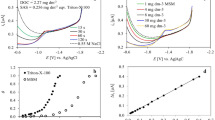Summary
The fulvic acid (FA) fractions of humic substances from river water and bog lakes and of humic-like substances from landfill leachates were isolated by the XAD-method and titrated by a cationic polyelectrolyte. The isoelectric point of net charge of the FA samples was calculated by the streaming current detection (SCD)-technique and a new parameter of charge density (aPC) was calculated from the titer volume. The aPC-values of the FA are low for humic like substances (0.22–1.76 μeq/mg DOC) and high (2.41–5.60 μeq/mg DOC) for humic substances. Polarographically determined Cu(II)-complexation capacities (CuCC) of humic-like substances are in good linear relationship to their aPC-values. Even though SCD-signals only supply qualitative information, a useful fingerprint of the FA sample is given by the shape of the titration curve.
Similar content being viewed by others
References
Gjessing ET (1976) Physical and chemical characteristics of aquatic humus. Ann Arbor Science, Ann Arbor, Michigan
Stevenson FJ (1982) Humus chemistry. John Wiley, New York
Frimmel FH, Christman RF (eds) (1988) Humic substances and their role in the environment. John Wiley, Chichester
Randtke SJ (1988) J Am Water Works Assoc 80:40–56
Sontheimer H, Crittenden JC, Summers FRS (1988) Activated carbon for water treatment. G. Braun GmbH, Karlsruhe, pp 511–537
Sposito G (1981) Environ Sci Technol 15:396–403
Rook JJ (1974) Water Treat Exam 23:234–243
Perdue EM, Reuter JH, Ghosal M (1980) Geochim Cosmochim Acta 44:1841–1851
Neubecker TA, Allen HE (1983) Wat Res 17:1–14
Gamble DS (1970) Can J Chem 48:2662–2669
Perdue EM (1985) In Aiken GR, McKnight DA, Wershaw RL, McCarthy P (eds) Humic substances in soil, sediment and water. John Wiley, New York, pp 493–559
Saar RA, Weber JH (1982) Environ Sci Technol 16:510A-517A
Tuschall JR, Brezonik PL (1983) In: Christman RF, Gjessing ET (eds) Aquatic and terrestrial humic materials. Ann Arbor Science, Ann Arbor, Michigan, pp 275–294
Hall ES, Packham RF (1965) J Am Water Works Assoc 57:1149–1166
Edwards GA, Amirtharajah A (1985) J Am Water Works Assoc 77:50–57
Dentel SK (1988) Environ Sci Technol 22:825–832
Dempsey BA, O'Melia CR (1983) In: Christman RF, Gjessing ET (eds) Aquatic terrestrial humic materials. Ann Arbor Science, Ann Arbor, Michigan, pp 239–273
Giesy JP, Alberts JJ, Evans DW (1986) Environ Toxicol Chem 5:139–154
Eberle SH, Feuerstein W (1979) Naturwissenschaften 66:572–573
Gamble DS (1972) Can J Chem 50:2680–2690
Frimmel FH, Hopp W, Quentin KE (1985) Z Wasser Abwasser Forsch 18:259–262
Nik EA, Carlson DA, Eikum AS, Gjessing ET (1985) J Am Water Works Assoc 77:58–66
Hundt TR, O'Melia CR (1988) J Am Water Works Assoc 80:176–186
Hamann CH, Vielstich W (1981) Elektrochemie I. Verlag Chemie, Weinheim, pp 165–167
Dentel SK, Thomas AV, Kingery KM (1989) Wat Res 23:413–421, 423–430
Kawamura S, Hanna GP, Shumate KS (1967) J Am Water Works Assoc 59:1003–1013
Narkis N, Rebhun M (1977) J Am Water Works Assoc 69:325–328
Glaser HT, Edzwald JK (1979) Environ Sci Technol 13:299–305
Spillmann P (1989) Intern. Symp. on Groundwater Management: Quantity and quality. Benidorm, Spain
Mantoura RFC, Riley JP (1975) Anal Chim Acta 76:97–106
Frimmel FH, Bauer H (1987) Sci Total Environ 62:139–148
Frimmel FH, Weis M (1988) Vom Wasser 71:255–267
Weis M, Abbt-Braun G, Frimmel FH (1989) Sci Total Environ 81/82:343–352
Abbt-Braun G; pers. commun.
Frimmel FH, Geywitz J (1983) Fresenius Z Anal Chem 325:68–72
Hayes MHB, Swift RS (1978) In: Greenland DJ, Hayes MHB (eds) The chemistry of soil constituents. John Wiley, Chichester, pp 276–282
Perdue EM, Lytle CR (1983) Environ Sci Technol 17:654–660
Weis M, Valera FS, Frimmel FH (1989) Z Wasser Abwasser Forsch 22 (in press)
Author information
Authors and Affiliations
Additional information
Dedicated to Prof. Dr. G. Tölg on the occasion of his 60th birthday
Rights and permissions
About this article
Cite this article
Weis, M., Frimmel, F.H. Electrochemical determination of the anionic particle charge of aquatic fulvic acids. Z. Anal. Chem. 335, 927–930 (1989). https://doi.org/10.1007/BF00466384
Received:
Issue Date:
DOI: https://doi.org/10.1007/BF00466384




